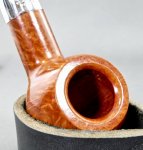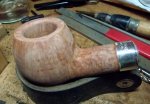I have always loved Pete's silver spigot pipes. Their silver work is generally quite good, and their shaping is both agreeable in design and they're well cut. (Those are the essentials. If they're off, there's no rewind button.) They also tend to have excellent wood, plus many of the lines are fill-free.
The stem work and stummel finishing of their spigots runs from reasonable/acceptable to poor, though, depending on the model (line), who's working that day, and etc. They CAN do truly amazing work---I've held it---but the realities of hitting price points dictates how much time can be spent on a particular specimen.
The main culprit is "blasting" many finishing steps with buffers and polishers so that material removal and gleam are accomplished simultaneously (or nearly so). Meaning instead of gently climbing through several grades of sandpaper and then several more of buffing compound when finishing a stem the way an artisan maker does, high speed wheels, heavy pressure, and frictional heat are used.
It is possible to have the best of both worlds, though---artisan result at a mass production cost---if you RE-do the finishing work yourself.
And here we are. A gorgeously grained and gorgeously cut fill-free "Prapple" (part prince, part apple) stummel sporting thick, shrink-wrap-tight sterling silver... that was only a few shop hours away from looking like a fine, high grade Danish pipe.
The stummel's heavy, plastic-y feeling finish and underlying ripples (think faint sandblast) were removed with some careful wet sanding using alcohol, the chamber was taken back to wood, and the stem was slightly re-bent and re-cut to remove surplus material and smooth things out.
Re-stain the stummel and re-polish the stem as you would for any high grade, and there you go.
.










The stem work and stummel finishing of their spigots runs from reasonable/acceptable to poor, though, depending on the model (line), who's working that day, and etc. They CAN do truly amazing work---I've held it---but the realities of hitting price points dictates how much time can be spent on a particular specimen.
The main culprit is "blasting" many finishing steps with buffers and polishers so that material removal and gleam are accomplished simultaneously (or nearly so). Meaning instead of gently climbing through several grades of sandpaper and then several more of buffing compound when finishing a stem the way an artisan maker does, high speed wheels, heavy pressure, and frictional heat are used.
It is possible to have the best of both worlds, though---artisan result at a mass production cost---if you RE-do the finishing work yourself.
And here we are. A gorgeously grained and gorgeously cut fill-free "Prapple" (part prince, part apple) stummel sporting thick, shrink-wrap-tight sterling silver... that was only a few shop hours away from looking like a fine, high grade Danish pipe.
The stummel's heavy, plastic-y feeling finish and underlying ripples (think faint sandblast) were removed with some careful wet sanding using alcohol, the chamber was taken back to wood, and the stem was slightly re-bent and re-cut to remove surplus material and smooth things out.
Re-stain the stummel and re-polish the stem as you would for any high grade, and there you go.
.


















